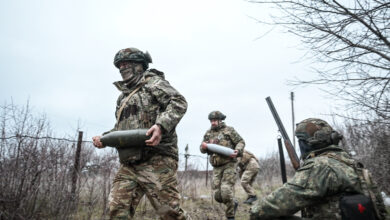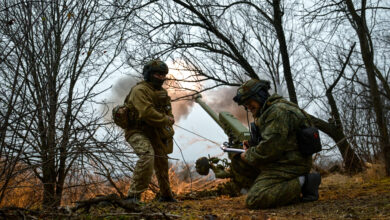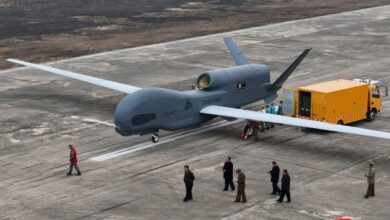
Air raid sirens ring out over cities, signaling to residents that it is time to seek shelter once more. Shelling continues, day after day, targeting homes, hospitals, and schools. For some, clean water has become scarce, and power and heat unavailable.
This is the new reality of the Ukrainian people.
Since the start of its invasion of Ukraine two weeks ago, Russia has been relentless in its attacks. When the full-scale assault began, the primary targets of the Russian military were Ukrainian military installations and infrastructure, a strategic move on Vladimir Putin’s part to weaken Ukraine’s ability to defend itself against the mounting invasion.
Only four days later, on February 28, that changed.
In Kharkiv, rocket strikes rained down on residential districts, killing at least 11 people. News outlets, heads of state, and international institutions scrambled to get answers for the sudden escalation; after all, only a few days before, Russia’s foreign minister Sergey Lavrov had said, “Nobody is going to attack the people of Ukraine. […] No strikes are being made on civilian infrastructure.”
But a strike did happen. And the people of Ukraine were attacked. And it didn’t stop after one day.
Intensified Russian Offensive
Six days after the first residential shelling, Russian forces had intensified their offensive in scope and magnitude. In addition to Kharkiv, the cities of Mariupol, Kyiv, Chernihiv, and Mykolaiv were now under attack as well.
Despite discussions of humanitarian corridors during ceasefire talks, safe passage never materialized as Russian forces continued to bombard a civilian evacuation route in Mariupol.

For civilians who remained trapped without the possibility of evacuation, survival meant sheltering from daily attacks amid cities that were quite literally crumbling around them as essential supplies began to dwindle.
Less than two weeks into the crisis, a spokesperson for the International Committee of the Red Cross called the situation “apocalyptic.” The number of refugees flowing out of Ukraine prompted Filippo Grandi, the UN High Commissioner for Refugees, to call it “the fastest-growing humanitarian crisis in Europe since World War II.”
What makes the Ukrainian crisis stand out the way it has? Is it the remarkable deluge of refugees flowing out of the country? Is it the terrifying conditions that civilians who remain in-country face on a daily basis? Is it the fear that there might be negative consequences for countries other than Ukraine?
Perhaps. But the world has seen plenty of humanitarian crises before – in fact, numerous humanitarian crises are occurring now. So why should this one be any different?
Narrative
Part of it is the narrative. The story of the Ukrainian crisis is not the typical story of invasion. Against the expectations of many – including experts on the region and apparently, Putin himself – Ukraine has managed to hold their own against Russian forces.
The unflappable courage and determination of the Ukrainian people can be seen in the willingness of many civilians to take up arms, from beauty queens to retired grandfathers.
Underdog stories do not usually play out successfully in international politics, which explains why this conflict has taken so many by surprise.
Escalating Violence
Another part of it is the gravity of the rapidly escalating violence. Yes, crises are always urgent, but the consistent intensity of the violence and the targets of attacks – mainly civilians – combine to create a disturbingly brutal picture, one that is rather shocking.
As shelling continues and the situation becomes more dire, Ukrainians are not only dying as a result of bombs and bullets, but also suffering from illness, infection, and untreated injuries.
Although the exact number of civilian casualties is unclear, the reality and extent of death are undeniable.
Conflict’s Location
Yet another part of it is that, for many observers, this conflict is a nightmare come true. After decades of tension between the West and Russia, many Westerners not only distrust Putin but fear him as well.
Putin’s decision to invade Ukraine and employ the tactics he has chosen is a sign to many that their fears were well-founded.

Another reason this crisis may resonate so much with Western observers is the location of the conflict. Ukraine’s geographical location allows it to essentially act as a buffer between the EU and Russia.
For Europeans, this adds an extra layer of relevance and concern: if Russia were able to overtake Ukraine, it would not only indicate the strength of Russian forces, but it would also mean that there would be nothing – territorially speaking – to insulate them from the threat of Russia.
Modern Media and Technology
But there is still one more element that has helped catapult the Ukrainian crisis to center stage: modern media and technology.
When news outlets, journalists, and even international organizations left the country, fleeing for safety, Ukrainian civilians stepped in to fill the gap, acting as impromptu reporters on the state of the crisis.
Filming attacks on civilians, advancing Russian troops, and the evacuation of refugees, Ukrainians have been able to tell the world the story of this crisis through their eyes.
On the news, not only Ukrainian politicians and public figures are invited to speak but also shopkeepers, young families, and grandparents with their grandchildren. Younger Ukrainians use social media to share their new reality with the world.
Outside of Ukraine, social media keeps the crisis in the spotlight, raising awareness, educating people, and moving people to action.
Content creators on TikTok are creating bite-sized explanations about the invasion, Russia’s strategies, and predictions for how the conflict might play out.
Experts and specialists on Eastern Europe and Eurasia on Twitter are using the platform to share their analyses and expertise. Crowdfunding efforts abound, collecting financial and logistical aid for Ukrainians in need.
Relatable
The response across social media and the internet has been so powerful that despite Putin’s best efforts – paying Russian influencers to post pro-Kremlin narratives on TikTok and banning Twitter and Facebook domestically – it is ultimately the Ukrainian narrative has taken the world by storm.
This final piece of the puzzle, modern media, has helped make the war in Ukraine a different kind of crisis. It makes the Ukrainian crisis relatable to the everyday person.
While the war itself may not be a relatable experience, being told about it by another civilian makes it seem more real and less foreign to us. And that sense of reality may very well be the difference between action and inaction, support and disregard.
And while that might mean some observers will be more affected or disturbed by what they see and hear, it might also mean that the result of that is more action.
 Maya Camargo-Vemuri (@camargovemuri) is a scholar of political violence. Her research examines conflict, civilian victimization, and repression with a regional focus on Eastern Europe and Eurasia. She is completing her PhD at Johns Hopkins University School of Advanced International Studies.
Maya Camargo-Vemuri (@camargovemuri) is a scholar of political violence. Her research examines conflict, civilian victimization, and repression with a regional focus on Eastern Europe and Eurasia. She is completing her PhD at Johns Hopkins University School of Advanced International Studies.
The views and opinions expressed here are those of the author and do not necessarily reflect the editorial position of The Defense Post.
The Defense Post aims to publish a wide range of high-quality opinion and analysis from a diverse array of people – do you want to send us yours? Click here to submit an op-ed.











